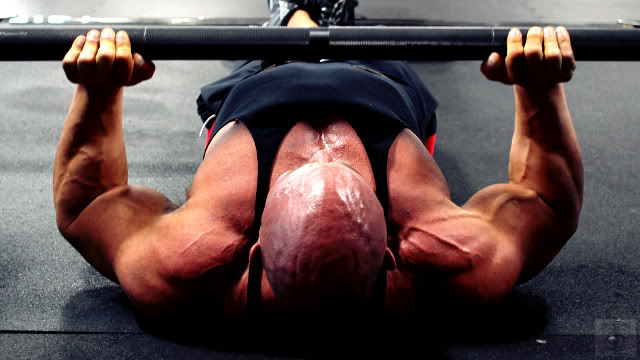The Suicide Grip (at times called the bogus grasp, a thumbless hold, or a neutralizer grasp) doesn't actually appear to be that much unique from a conventional hold on a bar when you hop on the bench.
The major difference here is that you slide your thumb from its traditional position on the opposing side of the bar from the rest of your fingers (a that adds additional strength and control) and rather adjust it to rest of the fingers on your hand.
Bar Placement: -
Suicide grip is for better bar placement when bench pressing, the bar sits in a superior situation to push from, anyway as the name propose this hold, in any event, when the smallest vacillate, jerk or slip happens can seal your fate. sits even more gently in the palm of your hand during the suicide grip, in any case any slight blunder in development and you're finished – going from a thumbless grip to a normal grasp as the bareball begins to slip is near to impossible.
Muscle Activation
The suicide grip is said to confine the muscle being trained all the more adequately. Despite the fact that you don't advocate utilizing the suicide grip on exercises, for example, the bench press. On back exercise, for example, the pend lay low, pull-up and lat pull-down you will be ready to sit the bar all the more easily in your grasp and feel further enactment in your back, rather than your biceps
Mindset
Hardcore powerlifters and bodybuilders utilize the suicide grip as a literal ‘Do or Die! Right when you're cutting down the hand weight with 315lbs down to your chest and no thumbs to get the bar in position you better aside from you're ready to control it back up to the starting position and complete that repetition.
What Exercises Should You Use Suicide Grip On?
Next time when you're playing out a back exercise try withdrawing your thumb from the bar and notice the difference – you'll probability feel that your back is working more diligently, as your biceps are presently not as conspicuously. You might need to drop the weight to hit similar number of reiterations, but in the long term except if you're attempting to hit your biceps with these exercises it will be more important in the long haul.
What Exercises Should You Avoid Suicide Grip On?
Any pushing movement that places you under the barbell should not be performed with a suicide grip, even with a spotter or two on reserve – when you have anything north of 225lbs on the barbell and you make one wrong action, the reaction time of your spotter will probably not be adequately fast to save your chest or neck from copping the full `force of that load as it drives downwards onto your chest. The deadlift is another exercise you don't perform with the suicide grip.
Advantages of Suicide Grip: -
1. Better Wrist Positioning
Utilizing a normal grip, you can pull off with bad wrist positioning with the wrists pointing back you have your thumbs to hold it back from falling. In the event that you are using a suicide grip. You are normally constrained to have your wrists straight (the right technique) to hold the bar back from exiting your hands.
2. Powers Your Bar Path to Be Optimal
In the event that you are using suicide grip, and you bring the bar too low towards your stomach then, at that point bar will basically carry out of your hands, this suggests that utilizing thumbless grasp constrains you to bring the bar down to an ideal situation for the bench press.
3. Loads the Lats
When utilizing a normal grip your thumbs are the cause of your forearms taking over from your lats. This implies when you remove the thumbs from the equation you are able to feel and activate your lats better, which gives you a steady base to push off during the bench press.
Disadvantages of suicide grip: -
1. Not Very Safe
The most well-known issue raised with the suicide grip is the health concern, it shouldn't be endeavoured by amateur lifters and all things considered, on the off chance that you utilize a thumbless grasp, any sort of bar development in your grasp will leave you in the emergency clinic with a couple of broken ribs, in case you're fortunate.
2. Not Allowed in Powerlifting
In the event that you're a Powerlifter who utilizes a suicide grip, it’s a terrible news for you, it's restricted in most of organizations like the IPF. You would prefer not to become accustomed to the thumbless grip just to discover you can't utilize it; you would fundamentally need to revamp your brain to bench in differentially– not ideal.
3. Can't Create Tightness
Going with a suicide grip mean you will not make the sort of tightness that you can accomplish through gripping the bar normally. To make this tightness you need to envision that you're twisting the bar separated, practically attempting to break it. This makes upper back and all-round tightness that you'd want in case you were going for a heavy single.
4. You Won't Be Able to Lift as Heavy
utilizing a thumbless grip just prevents you from using 100% of your force. You can’t squeeze the bar and effectively connect with the forearms. Having the option to squeeze the bar and tightens up permits you to utilize max effort, something that suicide grip prevents you from doing.
Conclusion
It’s actually is a very big deal and the difference could have some life altering consequences. on the off chance that you are one of those people who demands side-lining with a thumbless handle, bogus grasp, suicide grip hold or whatever else you need to call it, then, at that point, at that point kindly do as such using the power rack or the smith machine with the safety pins set at chest height.










